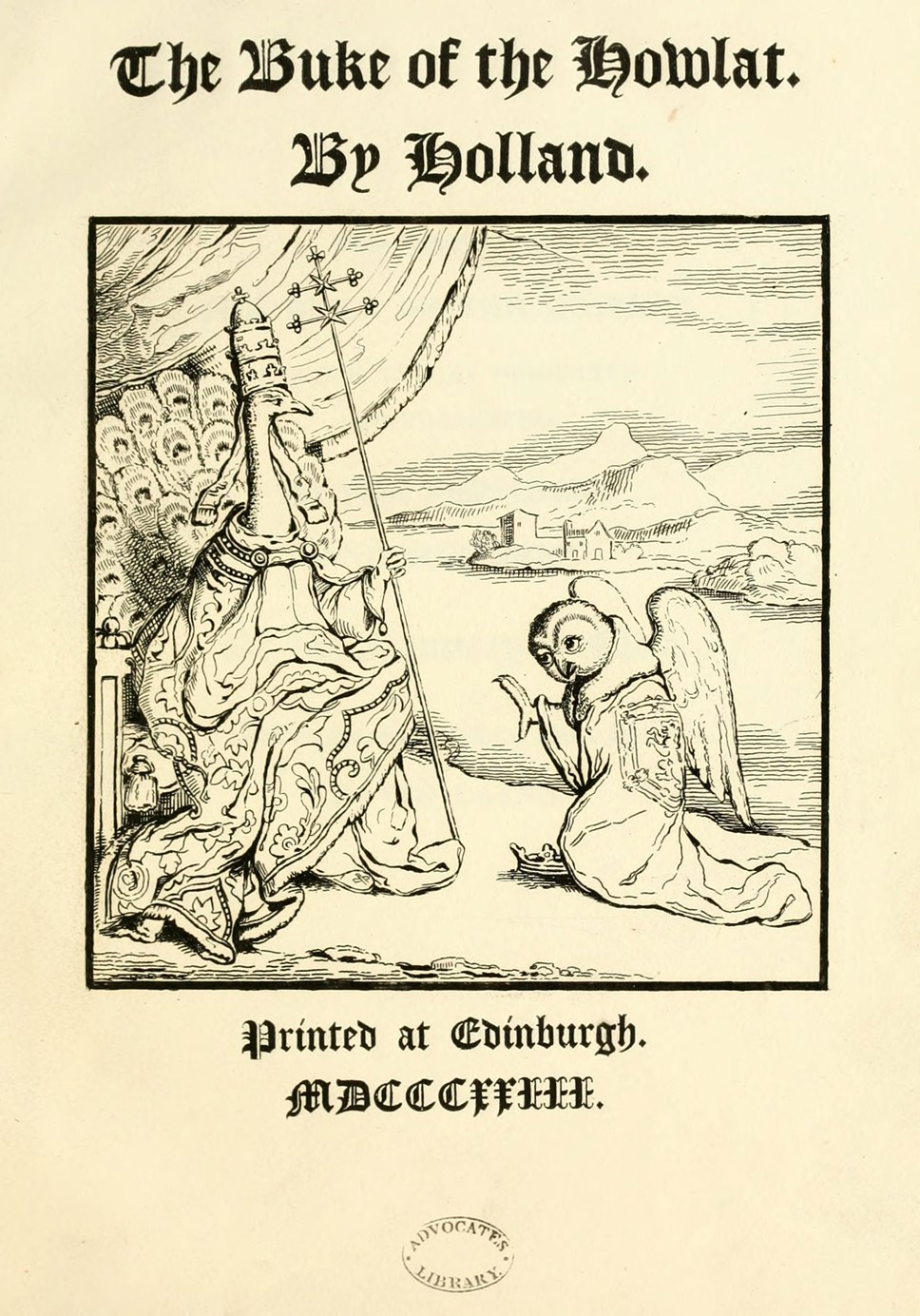
Website offers "windae" into Scots language
The Scots language as it has been spoken, written and enjoyed down the centuries is revealed in a new project developed at the National Library of Scotland.
Scotland’s Cabinet Secretary for Education John Swinney launched a new website today (Dec 1) that aims to raise awareness of the history, richness and cultural significance of Scots from its use as the language of the state in the Middle Ages to its appearance in 20th century novels and poetry.
The Wee Windaes website http://wee-windaes.nls.uk/ is based on a careful selection of Scots language material from the countless examples in the vast collections of the National Library. The oldest is a performance poem from the 1440s – The Buke of the Howlat – through to the 20th century writings of novelist and playwright Jessie Kesson. Examples of contemporary writing will be added as the site develops further.
It shows the use of Scots in many different forms including song, folk tale, scripture, satire, drama, fiction and poetry. The site itself is written in Scots with an English version. Visitors to the site can listen to many examples of spoken Scots as well as reading it in written form.
Mr Swinney said: “The Scots language is an essential element of our nation’s culture and heritage and this Government is committed to promoting and preserving it in all its distinct regional and local variants, which are spoken by around 1.5 million people. I very much welcome the launch of the Wee Windaes website, which shines a light on the breadth of Scots influence on our rich literary heritage throughout the centuries.”
Wee Windaes has been developed by the Scots Scriever, Hamish MacDonald who was appointed in 2015 by Creative Scotland to raise awareness of the language. He is based at the National Library where he has collaborated with the Library’s Learning Team on developing the site.
Hamish MacDonald said: "It is a privilege tae reenge amang the byous National Library collections, whan ilka sairch leads tae some new an unexpectit discovery, shawin throu literature the depth an wunner o a treisured an irreplaceable tung."
As its name suggests, the site is based on a series of “windaes,” each containing a link to more information about the various texts, most of which are being made available online for the first time. More authors and texts will be added to the site throughout 2017.
The Library will also be participating in a research afternoon for staff and students at the University of Edinburgh to showcase the work being done to promote Scots language and literature.
National Librarian Dr John Scally said: “The Scots language is very much part of our cultural identity and we are keen to help it thrive. By using the website, people will be able to get a better understanding of how Scots has been used and how it has changed over five centuries.”
Janet Archer, CEO, Creative Scotland, said: “We are pleased to support the Scots Scriever post as part of our commitment to raising awareness, appreciation and use of the Scots language across the country. Scots is part of our history and cultural heritage, with rich oral and written traditions that are still very much alive today. Wee Windaes is a creative response to Scots collections at the National Library of Scotland and a braw way to give the language further prominence. Wee Windaes captures the breadth and variety of Scots, in all its variants and dialects, from its beginnings to the present day and I hope it will inspire the writers of the future to explore the potential of the language.”
Examples of the use of Scots from the Wee Windaes website
Of a' the lingo's ever prentit,
The braidest Scot's the best inventit.
Robert Louis Stevenson
Thus all thir fowlis, fir my filth, has me at seid
That be I seyne in thar sicht
To luke out on day licht
Sum will me dulfully dicht
Sum dyng me to deid
From ‘The Buke of the Howlat’
Sae meikle Smeddum’s in your heel,
Nae yirthly weight can clog ye –
Not even Nick can damp your zeal
While at your ‘Reel o’ Bogie’
From ‘The Reel o’ Bogie’ by Alexander Rodger
Creep on’ hap siccar w’ your velvet faulds
the wearied day.
I ken nae noo familiar form o’ trees.
The loch lies phantom-like alow yer mists.
Nae glitter’s there, nae lithe, green limb o earth
leaps tae meet the wash o’ wave.
Dusk owre the loch, and dusk owre a’ my mind;
From Dusk by Jessie Kesson
Notes to Editors
National Library of Scotland
The National Library of Scotland is a major European research library and one of the world’s leading centres for the study of Scotland and the Scots - an information treasure trove for Scotland’s knowledge, history and culture.
The Library’s collections are of world-class importance. Key areas include digital material, rare books, manuscripts, maps, music, moving images, official publications, business information, science and technology, and the modern and foreign collections. The Library holds more than 25 million items dating back over 1000 years. This includes over four million books, eight million manuscripts, two million maps and over 45,000 films and videos. Every week it collects around 4,000 new items. Around 80% of these are received free of charge in terms of Legal Deposit legislation. Further information is available at www.nls.uk
Creative Scotland
Creative Scotland is the public body that supports the arts, screen and creative industries across all parts of Scotland on behalf of everyone who lives, works or visits here. They enable people and organisations to work in and experience the arts, screen and creative industries in Scotland by helping others to develop great ideas and bring them to life. They distribute funding provided by the Scottish Government and the National Lottery. For further information about Creative Scotland please visit www.creativescotland.com.
The role of Scots Scriever is jointly supported by Creative Scotland, with funding of £50,000, and the National Library of Scotland who will host the role, provide administrative support and access to their Scots archive. This is a unique type of writer residency with a high level of public engagement, a creative response to Scots collections at the National Library of Scotland, and regular ongoing output in Scots all required throughout the tenure. The purpose of the Scriever residency is specifically:
- to produce original, creative work in Scots (any variant or dialect) in any genre or discipline throughout the tenure
- to have explicit responsibility for raising the profile, understanding and appreciation of creative work in the Scots language, including that held within the National Library’s collections.
Creative Scotland’s Scots Language Policy was published on 3 June can be found here: http://www.creativescotland.com/resources/our-publications/plans-and-strategy-documents/scots-language-policy
